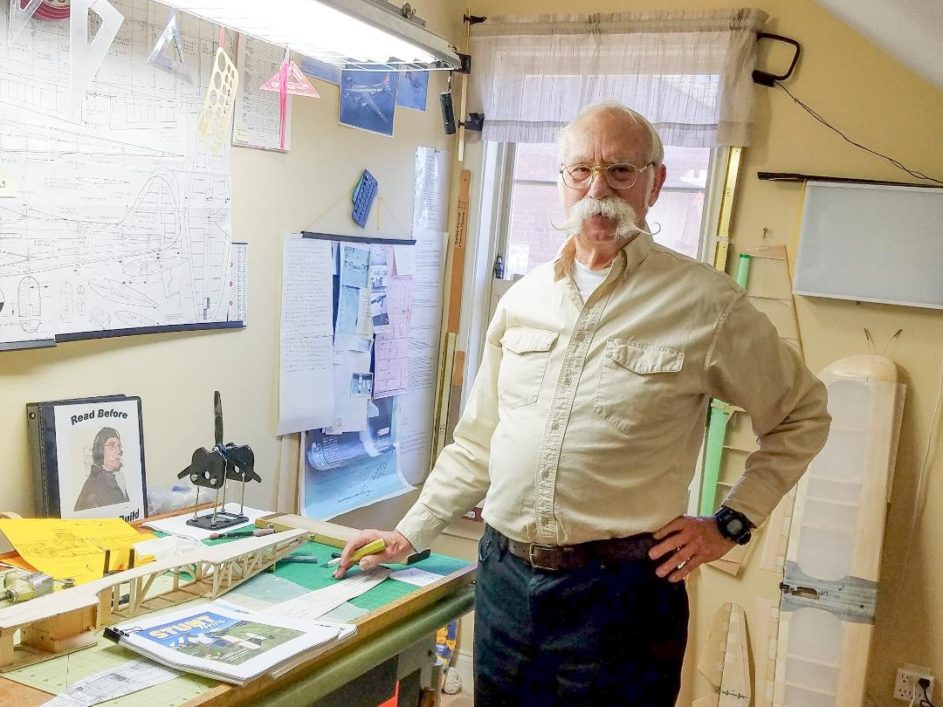For the aviation buff, there’s definitely one advantage to flying model aircraft instead of the real thing: “I’ve been able to walk away from all my crashes,” jokes T. Michael Jennings.
Jennings, who lives near Northshore Town Center in Southwest Knox County, builds and flies control-line model aircraft. These engine-powered models – with wingspans of about four feet – are flown with the use of a 65-foot steel control line.
He takes them to precision aerobatics competitions in which entrants are judged on their ability to fly the aircraft in about 15 different patterns.
He flies them for practice in large, vacant grass or asphalt lots, most recently at the ball-field parking lots at Concord Park. Finding a spot to fly is always a challenge.
“They put out a reasonable amount of noise,” he says.

Control-line model of a Bell P-39 Airacobra, built by T. Michael Jennings (Photo courtesy of T. Michael Jennings)
Kits are available for control-line aircraft, but Jennings prefers to buy plans and create his own pieces. He specializes in World War II aircraft and has a library’s worth of books on various craft, plus a card catalog of photos he’s taken at aircraft museums across the country. Prominent in his study at his home are completed models of American planes such as the Bell P-39 Airacobra and the P-51 D Mustang, a Soviet-made Yak-9, and a German Stuka dive bomber.
Jennings retired as a mechanical engineer from ORNL, and his workroom has plaques congratulating him on his professional service, side by side with his precision-aerobatics honors. For each plane he builds, he brings the weight of his skills as an engineer, building his own plane body parts out of balsa, rounding them and sanding them with custom tools of his own invention, applying epoxy and painting them.
“I enjoy building more than flying,” he says. “Building, I can dream up anything.”
He estimates it takes about 175 hours to complete a plane. He begins each one with a folder that includes the model plans and an image of the real-life aircraft. While he works, he jots down problems he comes across and how he solves them. These lessons learned are compiled into a “Read Before You Build” notebook that he reviews before he tackles any plane.
“It’s no fun to do the same dumb things twice,” he says.
Finding the hobby was a necessary joy for him. In the late 1970s, feeling the weight of overwork, he was walking through Oak Ridge one day when he spied a hobby shop and remembered the fun he had with stick-model airplane kits as a child. He refuses to count how many planes or engines he’s had since then, but for decades he’s chronicled his successes in hobby magazines such as “Stunt News” and “Control Line World.”
His wife, Liz, is an integral part of his hobby, as the two travel to competitions and museums. Tent campers, they’ve been to 48 states and several countries. Their twin daughters, now grown and working as engineers, were his original assistants. This year he and Liz will venture to North Carolina for a hobbyists’ meet-up and in August will head to Muncie, Ind., for the Precision Aerobatics Model Pilots Association’s National Model Aviation Day. They are also squeezing in a trip to Germany.
Jennings is active in a creative-writing group at the O’Connor Senior Center and is working on a collection of 300 short stories under 300 words. A Vietnam veteran, he guesses about 25 percent of his stories are about that war.
He’s also completed a book, in the copy-editing stages, about his build of the P-39.
“Each airplane has a lot of mistakes,” Jennings says. “But you get a lot to write about.”

